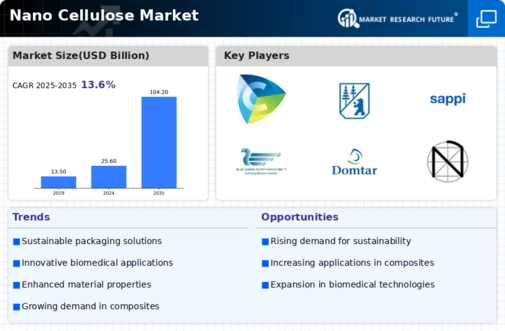Advancements in Nanotechnology
Advancements in nanotechnology are propelling the Global Nano Cellulose Market Industry forward, enabling the development of innovative applications across various sectors. Enhanced processing techniques and improved production methods have led to the creation of nano cellulose with superior properties, such as increased strength and lightweight characteristics. These advancements facilitate its use in high-performance composites, electronics, and biomedical applications. The anticipated growth trajectory, with a projected market value of 104.2 USD Billion by 2035, suggests that ongoing research and development will continue to unlock new potential for nano cellulose, further embedding it into diverse industrial applications.
Government Initiatives and Funding
Government initiatives and funding play a crucial role in the expansion of the Global Nano Cellulose Market Industry. Various governments are investing in research and development programs aimed at promoting sustainable materials and nanotechnology. For instance, funding for projects that explore the use of nano cellulose in construction and packaging is becoming increasingly common. These initiatives not only support innovation but also create a favorable regulatory environment for the commercialization of nano cellulose products. As a result, the market is expected to experience a compound annual growth rate of 13.61% from 2025 to 2035, driven by enhanced support from public sectors.
Chart Representation of Market Growth
Rising Demand for Sustainable Materials
The Global Nano Cellulose Market Industry is witnessing a surge in demand for sustainable materials, driven by increasing environmental awareness among consumers and industries. Nano cellulose, derived from renewable resources, offers a biodegradable alternative to conventional plastics. This shift is evident as companies seek to enhance their sustainability profiles, with many adopting nano cellulose in packaging, automotive, and construction sectors. The market is projected to reach 25.6 USD Billion in 2024, reflecting a growing inclination towards eco-friendly solutions. As regulations tighten around plastic use, the adoption of nano cellulose is likely to accelerate, positioning it as a pivotal material in the transition to a circular economy.
Growing Applications in the Medical Field
The Global Nano Cellulose Market Industry is experiencing significant growth due to its expanding applications in the medical field. Nano cellulose is being utilized in drug delivery systems, wound dressings, and tissue engineering, owing to its biocompatibility and ability to promote cell adhesion. The increasing prevalence of chronic diseases and the demand for advanced medical solutions are likely to drive this trend. As healthcare providers seek innovative materials that enhance patient outcomes, the adoption of nano cellulose in medical applications is expected to rise. This trend contributes to the overall market growth, aligning with the projected increase in market value to 104.2 USD Billion by 2035.













